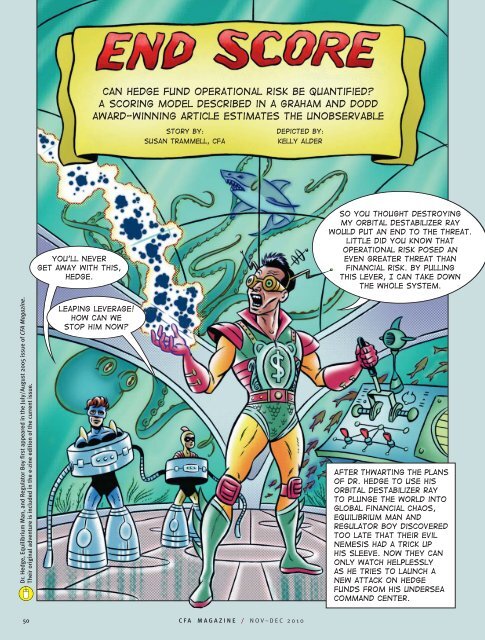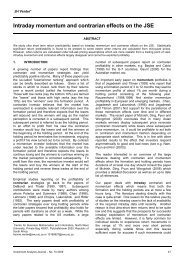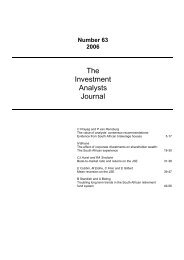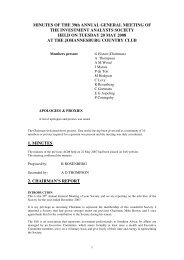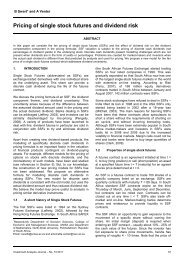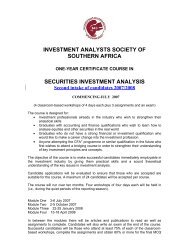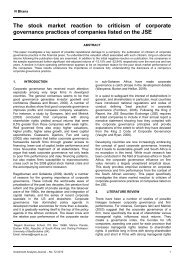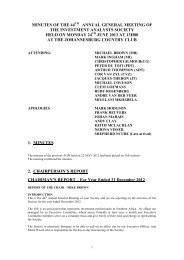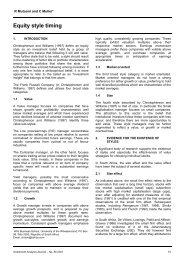Can hedge fund operational risk be quantified? - CFA Institute ...
Can hedge fund operational risk be quantified? - CFA Institute ...
Can hedge fund operational risk be quantified? - CFA Institute ...
Create successful ePaper yourself
Turn your PDF publications into a flip-book with our unique Google optimized e-Paper software.
<strong>Can</strong> <strong>hedge</strong> <strong>fund</strong> <strong>operational</strong> <strong>risk</strong> <strong>be</strong> <strong>quantified</strong>?<br />
A scoring model descri<strong>be</strong>d in a Graham and Dodd<br />
award-winning article estimates the unobservable<br />
story by:<br />
Susan Trammell, <strong>CFA</strong><br />
Depicted by:<br />
Kelly Alder<br />
Dr. Hedge, Equilibrium Man, and Regulator Boy first appeared in the July/August 2005 issue of <strong>CFA</strong> Magazine.<br />
Their original adventure is included in the e-zine edition of the current issue.<br />
You’ll never<br />
get away with this,<br />
Hedge.<br />
Leaping leverage!<br />
How can we<br />
stop him now?<br />
So you thought destroying<br />
my orbital destabilizer Ray<br />
would put an end to the threat.<br />
Little did you know that<br />
<strong>operational</strong> <strong>risk</strong> posed an<br />
even greater threat than<br />
financial <strong>risk</strong>. By pulling<br />
this lever, I can take down<br />
the whole system.<br />
After thwarting the plans<br />
of Dr. Hedge to use his<br />
orbital destabilizer ray<br />
to plunge the world into<br />
global financial chaos,<br />
Equilibrium Man and<br />
regulator Boy discovered<br />
too late that their evil<br />
nemesis had a trick up<br />
his sleeve. Now they can<br />
only watch helplessly<br />
as he tries to launch a<br />
new attack on <strong>hedge</strong><br />
<strong>fund</strong>s from his undersea<br />
command center.<br />
50<br />
<strong>CFA</strong> MAGAZINE / NOV–DEC 2010
1 “Understanding and Mitigating Operational<br />
Risk in Hedge Fund Investments,” Capital<br />
Markets Company (March 2003).<br />
2 Stephen Brown, William Goetzmann, Bing<br />
Liang, and Christopher Schwarz, Financial<br />
Analysts Journal (January/February 2009).<br />
Hedge <strong>fund</strong> blowups and their<br />
financial consequences grab<br />
headlines, but the media is<br />
often mum on the underlying causes<br />
when back-office issues are chiefly to<br />
blame. Yet an influential Capco Group<br />
study found that an astounding 50<br />
percent of <strong>hedge</strong> <strong>fund</strong> failures could<br />
<strong>be</strong> attributed to <strong>operational</strong> issues. 1<br />
Known for taking complex <strong>be</strong>ts<br />
that often involve illiquid securities,<br />
<strong>hedge</strong> <strong>fund</strong>s are subject to only<br />
modest regulatory oversight and can<br />
operate with little transparency for<br />
their many moving parts. Portfolio<br />
valuations and performance reporting<br />
generated with false and misleading<br />
information, misappropriation of<br />
<strong>fund</strong>s, and unauthorized trading<br />
topped Capco’s list of <strong>operational</strong><br />
issues among terminated <strong>hedge</strong><br />
<strong>fund</strong>s. Those hazards are only the tip<br />
of the ice<strong>be</strong>rg. Lapses may lurk in the<br />
execution of sophisticated trading<br />
strategies, the method of pricing <strong>fund</strong><br />
positions, accounting and auditing<br />
procedures, <strong>risk</strong> management techniques,<br />
legal and regulatory compliance,<br />
staff turnover, and technology<br />
limitations, to name but a few.<br />
The likelihood of poor subsequent<br />
performance increases with<br />
exposure to <strong>operational</strong> <strong>risk</strong>, which<br />
has <strong>be</strong>en shown to <strong>be</strong> a <strong>be</strong>tter predictor<br />
of <strong>fund</strong> failure than financial <strong>risk</strong>.<br />
But even prudent investors—the<br />
ones who perform in-depth due diligence<br />
<strong>be</strong>fore committing capital to a<br />
<strong>hedge</strong> <strong>fund</strong>—might not dig deeper<br />
than investment performance.<br />
“The fact that so many investors<br />
are willing to accept ‘trust me’ as the<br />
full extent and measure of their <strong>operational</strong><br />
due diligence suggested the<br />
importance of studying this issue in<br />
greater detail,” says Stephen Brown,<br />
NYU Stern School of Business professor<br />
and co-author of the 2009<br />
Graham and Dodd award-winning<br />
article “Estimating Operational Risk<br />
for Hedge Funds: The ω-Score.” 2<br />
“When it comes to looking at<br />
institutions’ involvement with <strong>hedge</strong><br />
<strong>fund</strong>s today,” Brown continues, “all<br />
the common-sense due diligence<br />
seems to have gone out the window.<br />
Hedge <strong>fund</strong>s are given a pass on the<br />
normal due diligence that any longonly<br />
manager would <strong>be</strong> expected to<br />
provide. I can understand the need to<br />
keep information about strategy and<br />
positions confidential, but it puzzles<br />
me that people are willing to take a<br />
trust-me attitude that they wouldn’t<br />
take with anyone else.”<br />
Gauging the Danger<br />
Brown, in conjunction with fellow<br />
academics William Goetzmann, Bing<br />
Liang, and Christopher Schwarz, set<br />
out to develop a methodology for<br />
estimating a firm’s <strong>operational</strong>-<strong>risk</strong><br />
exposure. The construct would produce<br />
one value, which the authors<br />
called the ω-score, or omega score,<br />
Meanwhile, a mild-mannered professor<br />
of finance is alerted to a sinister threat.<br />
which would help investors assess<br />
non-financial factors that could lead<br />
to <strong>hedge</strong> <strong>fund</strong> failure. The measure<br />
would have to <strong>be</strong> derived from publicly<br />
available information so that any<br />
sophisticated investor with the requisite<br />
quantitative skills could implement<br />
it. The score was not intended<br />
to substitute for <strong>operational</strong> due diligence<br />
but rather to <strong>be</strong> another tool in<br />
the investigative process.<br />
“The approach we talk about in<br />
our paper is very similar to something<br />
that is done in epidemiology,”<br />
Brown explains. “You have the vectors<br />
of disease, and then you have<br />
environmental exposures—you<br />
smoke, other <strong>risk</strong>y <strong>be</strong>havior. You try<br />
to correlate the environmental practice<br />
with the vectors of disease to<br />
come up with an index, or a score, of<br />
how dangerous a particular environment<br />
is.”<br />
To develop the ω-score, the<br />
researchers needed to establish relationships<br />
<strong>be</strong>tween two sets of variables:<br />
potentially unobservable <strong>operational</strong><br />
<strong>risk</strong> factors and observable<br />
Either my omega<br />
scanner is way off<br />
or the half-life of<br />
<strong>hedge</strong> <strong>fund</strong>s<br />
worldwide has just<br />
gone critical.<br />
<strong>CFA</strong> MAGAZINE / NOV–DEC 2010 51
<strong>hedge</strong> <strong>fund</strong> characteristics that have<br />
<strong>be</strong>en related to <strong>fund</strong> death by prior<br />
research. Using a statistical tool called<br />
canonical correlation analysis, the<br />
researchers weighted the variables in<br />
each set until the linear combinations<br />
yielded the maximum correlation<br />
<strong>be</strong>tween the two sets. The exercise<br />
produced a single value, or score, that<br />
could signal unknown <strong>operational</strong><br />
<strong>risk</strong> derived from easily accessible<br />
data in the sample dataset. Once the<br />
ω-score had <strong>be</strong>en successfully backtested,<br />
it was applied to <strong>fund</strong>s not<br />
used to construct the omega measure<br />
to see if the relationships would hold<br />
up. The results were validated.<br />
“The idea is to reduce a complicated,<br />
multidimensional problem into<br />
a simple statistic that any <strong>fund</strong> of<br />
<strong>hedge</strong> <strong>fund</strong>s can employ,” says<br />
Brown, who is also an investor in a<br />
management company that runs<br />
<strong>hedge</strong> <strong>fund</strong>s in Asia and his native<br />
Australia. “I wish I were wealthy<br />
enough to <strong>be</strong> a qualified investor in a<br />
<strong>fund</strong>,” he adds. “Unfortunately, I am<br />
an impecunious professor.”<br />
Getting Started<br />
The researchers’ starting point was<br />
Form ADV, a filing that all registered<br />
investment advisers that met certain<br />
parameters were required for a brief<br />
period to submit to the U.S. Securities<br />
and Exchange Commission by 1<br />
February 2006. Item 11 of the form is<br />
of particular interest <strong>be</strong>cause it identifies<br />
any problems of the <strong>fund</strong>’s management<br />
or its related advisory affiliates.<br />
These include criminal, civil,<br />
and regulatory issues. If a firm<br />
answers yes to any question in Item<br />
11, it is required to expand on the<br />
problem in an addendum. Form ADV<br />
also collects the names of direct and<br />
indirect owners of the firm, executive<br />
officers, control persons, other business<br />
locations of the firm, and the<br />
limited partnerships in which the<br />
investment adviser participates.<br />
The researchers focused on<br />
approximately 20 variables from the<br />
Forms ADV. The next step was to<br />
define <strong>fund</strong>s as problem or nonproblem<br />
<strong>fund</strong>s depending on whether the<br />
adviser had answered yes to any<br />
question in Item 11. Thus, issues of<br />
legal and regulatory compliance provided<br />
a simple and measurable proxy<br />
for <strong>operational</strong> <strong>risk</strong>.<br />
The third step was to focus on<br />
the relationship <strong>be</strong>tween the Form<br />
ADV variables and the performance<br />
statistics and characteristics of problem<br />
versus nonproblem <strong>fund</strong>s. From<br />
more than 20,000 Forms ADV, the<br />
researchers were able to match 879<br />
management firms with 2,299, or 57<br />
percent, of the more than 4,000 live<br />
<strong>fund</strong>s in the Lipper TASS <strong>hedge</strong> <strong>fund</strong><br />
database. Of these 879 management<br />
firms, 126 (approximately one in<br />
seven) answered yes to at least one<br />
question in Item 11. These firms represented<br />
368 <strong>fund</strong>s among the <strong>hedge</strong><br />
<strong>fund</strong> sample dataset.<br />
Using publicly available information<br />
from the TASS database, the<br />
researchers found that the problem<br />
<strong>fund</strong>s had not performed as well as<br />
the nonproblem <strong>fund</strong>s. The mean<br />
return and Sharpe ratio were both<br />
significantly lower and so were the<br />
incentive-fee level and the percentage<br />
using a high-water mark, perhaps<br />
This is a job for<br />
Omega Woman!<br />
indicating that problem <strong>fund</strong>s were of<br />
lower quality than nonproblem <strong>fund</strong>s.<br />
The research suggested that there is a<br />
significant positive interaction<br />
<strong>be</strong>tween <strong>operational</strong> <strong>risk</strong> and financial<br />
<strong>risk</strong>.<br />
Next, the Form ADV variables<br />
were classified as potentially posing<br />
internal, external, or ownership/<br />
capital-structure conflicts of interest.<br />
The analysis of Form ADV variables<br />
demonstrated that <strong>fund</strong>s with more<br />
conflict-of-interest issues, concentrated<br />
ownership, and lower leverage<br />
ratios tend to have higher past <strong>operational</strong><br />
<strong>risk</strong>, which suggested that<br />
such <strong>risk</strong> may also extend to future<br />
<strong>be</strong>havior.<br />
Estimating an Operational-Risk<br />
Measure<br />
The challenge was now to construct<br />
an <strong>operational</strong>-<strong>risk</strong> score for <strong>fund</strong>s<br />
whose managers did not file Form<br />
ADV. In previous research, Brown et<br />
al. had identified observable TASS<br />
variables shown to <strong>be</strong> associated with<br />
the probability of <strong>fund</strong> failure. Other<br />
characteristic data from TASS relating<br />
to <strong>fund</strong> quality were also included.<br />
Using canonical correlation analysis,<br />
they estimated a linear combination<br />
of these variables in such a way that<br />
52<br />
<strong>CFA</strong> MAGAZINE / NOV–DEC 2010
the resulting variable maximally correlated<br />
with a variable similarly constructed<br />
from a weighted set of Form<br />
ADV variables (such as conflicts of<br />
interest and ownership structure).<br />
Such variables, unless a firm had filed<br />
Form ADV, would <strong>be</strong> potentially<br />
unobservable.<br />
Significant, informative relationships<br />
<strong>be</strong>tween <strong>fund</strong> failure and certain<br />
<strong>operational</strong> factors were observed.<br />
Final Steps<br />
The statistical results suggested that<br />
a <strong>fund</strong>’s ω-score functioned as an<br />
indirect measure of <strong>operational</strong> <strong>risk</strong>,<br />
with the <strong>risk</strong> of failure increasing with<br />
a rise in score. After controlling for<br />
market <strong>risk</strong> and style differences, <strong>fund</strong><br />
returns were regressed on the ω-score<br />
for <strong>hedge</strong> <strong>fund</strong>s in the TASS database<br />
from 1994 to 2005. The results of the<br />
backtest suggested that <strong>operational</strong><br />
<strong>risk</strong> is negatively related to <strong>fund</strong><br />
returns, with a negative ω-score coefficient<br />
observed for returns in 10 of<br />
the 12 years and an average negative<br />
ω-score coefficient observed over<br />
the entire 12-year period.<br />
Finally, the researchers wanted to<br />
see whether the ω-score could deliver<br />
a prognosis of the survivability of<br />
Volatility (prior monthly standard deviation)<br />
0.7<br />
0.6<br />
0.5<br />
0.4<br />
0.3<br />
0.2<br />
0.1<br />
<strong>fund</strong>s not in the sample, as measured<br />
by the time to liquidation. If the relationships<br />
could hold up out of sample,<br />
it is highly probable that they would<br />
hold in the future. Figure 1 shows<br />
the projected half-life of <strong>fund</strong>s based<br />
on their ω-score and return volatility<br />
(a measure of financial <strong>risk</strong>). The<br />
ω-score was an accurate predictor of<br />
the disappearance of <strong>fund</strong>s from the<br />
sample: the higher the ω-score, the<br />
shorter the projected <strong>fund</strong> life.<br />
The ω-score is significant for<br />
such styles as convertible arbitrage,<br />
Lucky for me the Omega<br />
Scanner's tracking app<br />
was just updated, or<br />
I never would've found<br />
Dr. Hedge's secret lair.<br />
FIGURE 1<br />
Projected Half-Life of Fund Based on ω-score and Fund Volatility<br />
0.4 0.6 0.8 1 1.2<br />
Omega Score<br />
90<br />
80<br />
70<br />
60<br />
50<br />
40<br />
Note: This figure depicts the half-life<br />
of <strong>fund</strong>s as a function of both <strong>operational</strong><br />
(ω-score) and financial (volatility) <strong>risk</strong>.<br />
The projected life span (shown in months)<br />
falls as the ω-score rises, and half of all<br />
<strong>hedge</strong> <strong>fund</strong>s with a ω-score greater than<br />
1 are dead within a little more than<br />
50 months. Although <strong>operational</strong> <strong>risk</strong> is<br />
clearly the more important factor in<br />
determining the half-life of <strong>fund</strong>s, financial<br />
<strong>risk</strong> tends to magnify the deleterious<br />
effects of excessive <strong>operational</strong> <strong>risk</strong>.<br />
dedicated short bias, emerging markets,<br />
equity market neutral, <strong>fund</strong> of<br />
<strong>fund</strong>s, and long–short equity. The<br />
findings imply that <strong>operational</strong> <strong>risk</strong> is<br />
an important reason for <strong>fund</strong> failures<br />
in these categories. The coefficients<br />
are insignificant, however, for such<br />
styles as event driven, fixed-income<br />
arbitrage, global macro, and managed<br />
futures. For these categories, financial<br />
<strong>risk</strong> or other types of <strong>risk</strong> may <strong>be</strong><br />
important co-factors of <strong>fund</strong> failures.<br />
For such styles as convertible arbitrage,<br />
emerging markets, event<br />
driven, <strong>fund</strong> of <strong>fund</strong>s, and managed<br />
futures, higher <strong>operational</strong> <strong>risk</strong> is also<br />
related to higher financial <strong>risk</strong>.<br />
No Substitute<br />
Numerical scoring models are not<br />
new to the investment industry.<br />
Altman’s Z-score model, for example,<br />
evaluates the ambient factors that<br />
anticipate a company’s bankruptcy.<br />
Although a quantitative model can<br />
never fully replace human judgment,<br />
it can help prioritize the due-diligence<br />
process.<br />
“I think the reason this particular<br />
article [“Estimating Operational<br />
Risk for Hedge Funds: The ω-Score”]<br />
stood out among the many solid articles<br />
published in FAJ last year is<br />
<strong>be</strong>cause it is exceptional in both quality<br />
and relevance,” says Rodney<br />
Sullivan, <strong>CFA</strong>, FAJ’s editor, who<br />
reviews all articles but doesn’t get to<br />
vote on the Graham and Dodd<br />
<strong>CFA</strong> MAGAZINE / NOV–DEC 2010 53
Not so fast,<br />
Dr. Hedge!<br />
Graham and Dodd<br />
Awards of Excellence<br />
The Graham and Dodd Award for Best<br />
Article is presented annually for the<br />
most outstanding article published in<br />
the previous year’s Financial Analysts<br />
Journal. In addition, several articles are<br />
chosen to receive the highly respected<br />
Graham and Dodd Scroll Awards. The<br />
Scroll Awards salute excellence in<br />
financial writing while paying tribute<br />
to Graham and Dodd. The Graham and<br />
Dodd Best Perspectives Award recognizes<br />
the favorite Perspectives column<br />
among a subset of the voting body.<br />
FAJ readers are also invited to weigh<br />
in by casting their vote electronically<br />
for the most thought-provoking article<br />
from their viewpoint (the Readers’<br />
Choice Award). The 2009 winners<br />
(recognized in 2010) are as follows:<br />
Best Article<br />
“Estimating Operational Risk for<br />
Hedge Funds: The ω-Score” by<br />
Stephen Brown, William Goetzmann,<br />
Bing Liang, and Christopher Schwarz<br />
(January/February 2009).<br />
Scroll Awards<br />
“Absence of Value: An Analysis of<br />
Investment Allocation Decisions by<br />
Institutional Plan Sponsors” by Scott<br />
D. Stewart, <strong>CFA</strong>, John J. Neumann, Chris -<br />
topher R. Knittel, and Jeffrey Heisler, <strong>CFA</strong><br />
(Novem<strong>be</strong>r/Decem<strong>be</strong>r 2009).<br />
“Do Security Analysts Reduce Noise?”<br />
by Maria Schutte and Emre Unlu<br />
(May/June 2009).<br />
“The Wages of Social Responsibility”<br />
by Meir Statman and Denys Glushkov<br />
(July/August 2009).<br />
Best Perspectives Award<br />
“Markets in Crisis” by John C. Bogle<br />
(January/February 2009).<br />
Readers’ Choice Award<br />
“Tumbling Tower of Ba<strong>be</strong>l: Subprime<br />
Securitization and the Credit Crisis”<br />
by Bruce I. Jacobs (March/April 2009).<br />
Nooooooooo!<br />
awards. “By quality, I mean that the<br />
research was done in a very rigorous<br />
fashion. The authors use a type of<br />
hazard function, similar to that used<br />
in the insurance industry to estimate<br />
the probability of an insurable event<br />
such as an earthquake or auto accident,<br />
so these are advanced applied<br />
statistical concepts.”<br />
“What is even more important,<br />
though, is the article’s high degree of<br />
relevance to the investment community,”<br />
he continues. “It speaks to a<br />
very timely and important topic to<br />
investors—those in a fiduciary capacity<br />
need to consider a wide array of<br />
<strong>risk</strong>s in performing due diligence.<br />
This means not only investment <strong>risk</strong><br />
but also <strong>operational</strong> <strong>risk</strong>. This paper<br />
provides an important tool in helping<br />
us assess the <strong>risk</strong> that relates to maintaining<br />
a viable ongoing operation.”<br />
The idea of the ω-score is to<br />
reduce a complicated, multidimensional<br />
problem to a simple statistic<br />
that any <strong>fund</strong> of <strong>hedge</strong> <strong>fund</strong>s can<br />
employ. Yet, as Brown is quick to<br />
point out, for all of its merits, the ω-<br />
score could never replace full-blown<br />
<strong>hedge</strong> <strong>fund</strong> <strong>operational</strong> due diligence,<br />
which is a lengthy and expensive<br />
commitment. The process involves<br />
interviewing managers on site, dissecting<br />
the procedures for valuing<br />
securities and calculating the <strong>fund</strong>’s<br />
net asset value, conducting background<br />
checks, verifying the authenticity<br />
of audits, examining <strong>risk</strong> management<br />
infrastructure, and<br />
evaluating compliance procedures.<br />
And that’s just for starters.<br />
Operational due diligence may <strong>be</strong><br />
conducted by an investor’s in-house<br />
team or outsourced to a due diligence<br />
firm, or an investor may rely on a<br />
combination of internal and external<br />
resources. Each <strong>hedge</strong> <strong>fund</strong> has its<br />
own unique set of characteristics, and<br />
the evaluation will pull in not only<br />
auditors, lawyers, and administrators<br />
but also specialists whose expertise is<br />
particularly suitable to the <strong>fund</strong> <strong>be</strong>ing<br />
evaluated.<br />
“The questions that you’re asking<br />
in broad categories are generally the<br />
same, but they’re going to <strong>be</strong> tailored<br />
within those categories to <strong>be</strong> <strong>fund</strong><br />
specific,” says Jessica Davis, attorney<br />
and chief compliance officer for<br />
Protégé Partners, a large <strong>fund</strong>-of<strong>hedge</strong>-<strong>fund</strong>s<br />
manager. “There’s a wide<br />
variety of <strong>fund</strong> strategies, management<br />
structures, and so on. What<br />
may <strong>be</strong> perfectly fine for one <strong>fund</strong><br />
may <strong>be</strong> <strong>risk</strong>y for another.” Davis,<br />
along with Daniel Federmann, <strong>CFA</strong>,<br />
CPA, Protégé’s chief financial officer,<br />
spearheads the firm’s <strong>operational</strong> due<br />
diligence team.<br />
54<br />
<strong>CFA</strong> MAGAZINE / NOV–DEC 2010
“We bring our practical experience<br />
to <strong>be</strong>ar on the process,” Feder -<br />
mann adds. “When we review other<br />
managers, we know what’s inside the<br />
sausage factory, if you will.” Protégé<br />
also relies on a dedicated due-diligence<br />
firm to complement its efforts.<br />
“Independence is a big issue for us.<br />
Our work stands by itself, but having<br />
an external consultant, someone dedicated<br />
solely to <strong>operational</strong> due diligence<br />
and who’s unbiased, who’s not<br />
a mem<strong>be</strong>r of the partnership or the<br />
management company, and who can’t<br />
<strong>be</strong> influenced at all, is hugely important<br />
to us,” says Federmann.<br />
Seeking Alpha<br />
At Protégé, expenses associated with<br />
due diligence conducted by the internal<br />
team are borne by the firm;<br />
expenses associated with commissioned<br />
work are allocated to the partnership.<br />
Brown and his colleagues,<br />
following up on their award-winning<br />
paper, examined data directly from<br />
commissioned <strong>operational</strong> due-diligence<br />
reports of one such dedicated<br />
consulting firm. 3 They found that<br />
reports are typically 100–200 pages<br />
long and cost an average of US$12,500.<br />
The researchers have hypothesized<br />
that large <strong>fund</strong>s of <strong>hedge</strong> <strong>fund</strong>s<br />
that can absorb the high cost of due<br />
diligence and operate at a competitive<br />
advantage relative to smaller <strong>fund</strong>s of<br />
<strong>hedge</strong> <strong>fund</strong>s. 4 For example, Protégé<br />
Partners, which has more than US$3<br />
billion under management, has the<br />
internal resources to tackle a facet of<br />
the most important <strong>operational</strong> <strong>risk</strong><br />
factor underlying <strong>fund</strong> failure—the<br />
valuation of difficult-to-price securities.<br />
Protégé’s proprietary algorithm,<br />
called the Bias Ratio, measures the<br />
potential for return smoothing among<br />
<strong>hedge</strong> <strong>fund</strong>s trading illiquid assets.<br />
The formula has <strong>be</strong>en incorporated<br />
by some <strong>risk</strong> management database<br />
services as part of their offering.<br />
Ironically, it appears that <strong>operational</strong><br />
<strong>risk</strong> factors do not impede <strong>fund</strong><br />
flow. A recent decision model constructed<br />
by the four authors shows<br />
that <strong>operational</strong> due-diligence reports<br />
are typically issued on high-return<br />
<strong>fund</strong>s nine months after the historical<br />
performance has peaked and three<br />
months after the investor flows have<br />
peaked. “Operational <strong>risk</strong> is understood<br />
by sophisticated investors,”<br />
concludes Brown, “but it doesn’t mitigate<br />
the naive tendency to chase past<br />
returns regardless of <strong>operational</strong> <strong>risk</strong><br />
exposure.”<br />
Susan Trammell, <strong>CFA</strong>, provides business<br />
plan writing and market research<br />
services through her New York City<br />
consulting firm.<br />
3 Stephen Brown, William Goetzmann, Bing Liang, and Christopher Schwarz, “Trust and Delegation,”<br />
National Bureau of Economic Research working paper (Novem<strong>be</strong>r 2009).<br />
4 Stephen Brown, Thomas Fraser, and Bing Liang, “Hedge Fund Due Diligence: A Source of Alpha<br />
in a Hedge Fund Portfolio Strategy,” Journal of Investment Management (January 2008).<br />
How can we ever repay you,<br />
Omega Woman?<br />
You can start<br />
by staying on top of<br />
the latest research.<br />
I Guess Dr. Hedge just<br />
learned a valuable lesson.<br />
Crime may not pay, but<br />
<strong>operational</strong> due diligence<br />
sure can.<br />
<strong>CFA</strong> MAGAZINE / NOV–DEC 2010 55


